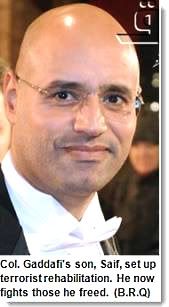By Michael Collins
Monday was the day we heard that the "US believes al-Qa'ida is on the verge of defeat after deputy leader's death" as The Independent
headlined the story. It stood out as a sequel to the recent United
States action in Pakistan, which brought us the news (but not the body)
of a dead Osama bin Laden. It appears that a US operated drone killed Al
Qaeda's top deputy, one Atiyah Abd al-Rahman, a Libyan citizen. After
decades as a jihadist, Rahman is no more. But is that the end of al
Qaeda? (Image: B.R.Q.)
On Tuesday, foreign affairs columnist for the Asia Times, Pepe Escobar, published a remarkable column outlining the command structure of the victorious NATO backed military leaders. Abdelhakim Belhaj, the lead commander of the rebels and the next two commanders, in terms of power, were once affiliated with the Libyan Islamic Fighting Group (LGIF). In fact, commander Belhaj was once the subject of a US led extraordinary rendition (aka torture) in Thailand. About the time the US planned to send Belhaj to Guantanamo Bay, the Libyan government of Gaddafi requested his return to Libya.
Terrorist Rehab, Libyan Style
At this point, you may be thinking, "Good grief, that's when the real torture started!" Au contraire! The request for repatriation came from none other than Saif Al-Islam Gaddafi, son of Libya's former dictator Muammar Gaddafi.
Saif, and others in the Gaddafi government, began a bold program of repatriating and rehabilitating individuals belonging to LGIF and other jihadist groups. Many fled Libya for Afghanistan where they fought with al Qaeda against the Soviet Union and then the United States Afghan effort. The LGIF had engaged in violent resistance to the Gaddafi regime. A large contingent of the LGIF fought the US in Iraq. According to reports, they "officially joined al Qaeda" in November 2007.
Saif Al Islam Gaddafi had a better idea:
"Saif
Gaddafi worked hard to get individuals from the Muslim Brotherhood out
of jail and paved the way for increase cooperation between the LIFG and
the security services. This helped boost the level of mutual confidence
between them." Combating Terrorism in Libya through Dialog and Reintegration, March 2010 p, 6
The gathering of terrorists in Libya served a purpose - terrorist rehabilitation or deradicalization, as the program termed it. Efforts focused on intensive dialog and debate between those employed by the Gaddafi regime and the terrorists. The main goals were a renunciation of violence and surrender of their weapons. From there, a holistic approach was applied to lay the foundations for a reintegration into Libya society. Psychological and social factors were included to reorient those detained as they adapted to a peaceful existence.
On graduation day in March, 2010, Saif Al-Islam presided over a formal press conference. As he freed 214 former members of LGIF, the Muslim Brotherhood, and other groups hostile to his regime, he said:
"Today is
an important day because 214 prisoners are released. However, its
greatest importance lies in the release of the group's leaders, and
therefore, today, we have reached the crest of the reconciliation and
dialogue program. Thanks to the efforts of our brothers and the Gaddafi
Foundation, 705 people were released including of course this group. Saif Al-Islam Gaddafi, Press Conference in Tripoli, March 23, 2010 p, 13
It was less than a year later that the February 17, 2011 days of rage marked the start of the Libyan rebellion led by the graduates of the deradicalization program. This was the same program initiated by Gaddafi's son and sponsored by the Gaddafi International Foundation for Charitable Associations.
The rehabilitation failed.
The Bush Administrations Gaddafi Rehab Program
Before Muammar Gaddafi and his son started their terrorist rehabilitation program, the Bush Administration conducted its own deradicalization effort with Gaddafi. On May 15, 2006, the US restored diplomatic relations with Libya. Then Secretary of State, Condoleezza Rice said, "We are taking these actions in recognition of Libya's continued commitment to its renunciation of terrorism."
(Note: You can view every article as one long page if you sign up as an Advocate Member, or higher).





